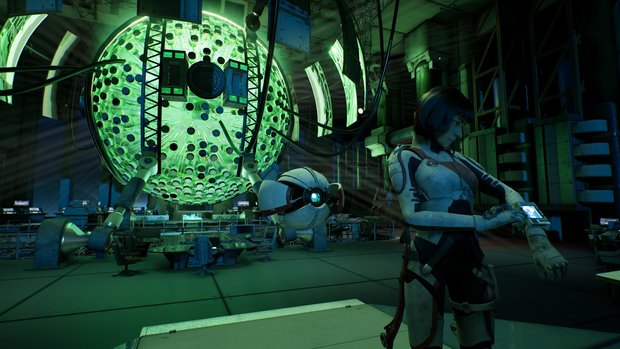Deliver Us Mars review – Solid sci-fi sequel roves farther but lands a little short of predecessor

- 0 Comments
In 2018, KeokeN Interactive launched Deliver Us the Moon, a futuristic sci-fi adventure in which Earth, drained of its natural resources and facing perpetual desertification, is getting close to an uninhabitable state. Facing extinction, humanity turns to the moon to supply it with life-sustaining energy, but when something goes wrong a lone astronaut is sent on a desperate Hail Mary mission to save mankind. The game was full of thrilling exploration and interesting plot twists, and combing an abandoned lunar station for hints and clues about the fate of its crew was an enthralling experience. The lonely but beautiful environment, at once hostile and somehow eerily peaceful, made me enjoy each moment, and it was strangely refreshing to roam the blinding-white blasted moonscape and yet never (well, rarely) be in any actual danger. Best of all, the narrative was intriguing and each new discovery served as motivation to push forward to “just one more” story beat. In short: I thoroughly loved Deliver Us the Moon.
Fast-forward a few years and the developer has set its sights on a new destination with the sequel, Deliver Us Mars. This game’s setup is quite similar: you prepare for a mission to the Red Planet (this time as part of a crew) to track down the previous game’s fugitive colonists and recover their life-sustaining ARK ships to save the still-decaying Earth. Most of the cast will be familiar to those who’ve played the original game. You take on the role of Kathy Johanson, daughter of the brilliant scientist Isaac Johanson who played such a pivotal role in the proceedings the last time around. Kat is now a young woman and a budding astronaut in her own right, joined by her older sister Claire, who oversaw the previous lunar mission), Sarah Baker (whose run-in with Isaac was one of the last game’s most memorable moments) and Sarah’s partner Ryan.
It's not surprising that the sequel stars a new character, based on the fates of the first game’s cast. This time Kat herself takes center stage, which seems appropriate considering the strong father-daughter dynamic that’s already been established between her and Isaac. And yet the intro level here sort of pulled the rug out from under me when Isaac leaves for Mars without her, which made me sad given the lengths he went to bring her along last time, even embracing violent acts in the process. Sure, it provides a strong private motive for Kat to join the Mars mission a few years later, but along with some seeming discrepancies involving Claire, I couldn’t shake the feeling that the gap between the two games wasn’t bridged in the smoothest way possible.

Anyway, by the time Kat sets off for Mars, ten years have passed since the events of the first game, making the bulk of this one a mostly self-contained affair without the constant need to reference the events of Moon (though several satisfying nods are included in the early chapters). Since you’re heading out with a crew of four rather than being on your own, the evolving character relationships are of vital importance, particularly since the strands binding everyone together are rather complicated: Big sister Claire is still holding onto her long-standing animosity toward her father, while Sarah’s lingering resentment of Isaac causes her to become fanatical about finally capturing him, and by extension showing very little courtesy and patience toward his youngest daughter. Meanwhile, Kat tries to fool everyone that she’s along for the sake of saving the Earth, but her hidden wish to find and save her father puts her at constant odds with the rest of the team. I love how much more personal the story and characters feel this time around, although a few more genuine bonds of friendship could have woven some lightheartedness into the rather grim web of character motivations.
In terms of gameplay, Deliver Us Mars is not a huge deviation from its predecessor. The story is delivered largely by navigating the various third-person, free-roaming 3D research stations and habitats Kat discovers on Mars while searching for clues to her father’s whereabouts, though there are some early sections that take place on Earth and aboard the spaceship en route to Mars. While walking around (or occasionally propelling gently forward in zero G by activating your suit’s build-in thruster), Kat will encounter some obstacles in her path. Her wrist-mounted laser can once again make short work of metallic clasps sealing doors or panels. Slightly more problematic are the numerous unpowered devices and terminals that act as the game’s primary puzzles. Kat, being an expert in the same Streame energy technology present in the previous game, must route power back to these devices by targeting them with nearby MPT energy beams. While most of these puzzles are generally fairly simple, a number of them involve multiple devices that must be powered simultaneously or in a certain order, and Kat may need to use portable splitters and dampening fields to alter the beams’ intensity, introducing more variables to the formula.
The majority of your time, however, will be spent exploring the environment and unearthing tidbits of the story. As before, the various facilities Kat runs across have all been abandoned, with some major conflicts obviously having occurred before her arrival. Like Rolf (Moon’s protagonist) before her, Kat is accompanied by an A.S.E. unit – a small, spherical robot named AYLA that hovers alongside her and can be piloted in first-person to scan objects of interest, open locked doors, and decipher encrypted holographic recordings (via a spatial mini-game where you have to position AYLA so that her x-, y- and z-axes are lined up in a specific way). It’s these holographic snippets that, little by little, reveal the fate of the erstwhile lunar refugees who made their way here. Unfortunately, the storytelling this time around is just a tad less engaging than before, as their ultimate fate doesn’t really factor into the stakes that much. During the moon mission, humanity’s very survival depended on discovering what happened and restoring the power feed. This time, that same sense of urgency has been throttled down – humanity has already held on several more years, and your mission to Mars doesn’t seem as pressing, instead providing more of a convenient excuse for Kat to search for her father.

There’s a greater push to explore the exterior surface this time around, via numerous rover driving sections or, occasionally, on foot. Like before, there is very little that can actually harm Kat, so those who don’t enjoy action elements needn’t fear. The rover only serves to get Kat from one zone to another, usually marked by an environmental or time change. For example, at one point Kat drives to an icy section of the planet (which sounds rather scientifically inaccurate to me). Rather than add something new and exciting to the gameplay, these changes in scenery actually further compound the issues of the fractured narrative. Levels seem more like separate entities and will often begin with Kat having already arrived in a new locale as the loading screen fades away, with no cohesion between areas whatsoever. While the trek across the moon seemed like one continuous journey, Kat’s excursion consists of several unconnected locations, and the game’s sense of place suffers from it.
To facilitate the increased planetside exploration, Kat is able to climb along porous walls with the help of two handheld climbing axes, similar to what a mountain climber would be equipped with. However, this turns out to be an unwelcome addition, mostly due to the mechanic’s slow and plodding execution. Each axe is controlled via a separate button (in my case, the control pad’s shoulder triggers) which must remain pressed in order to keep the axe’s grip. Climbing then requires a slow and deliberate moving and repositioning of each individual axe – one at a time, over and over – to make incremental progress without plummeting to your death. Unfortunately, climbable surfaces are often anything but straight and may contain sections or seams that the axes cannot penetrate, requiring incremental back and forth adjustments; running out of patience and rushing through a climbing section (like I did more than once) often leads to falling and having to redo the section altogether.
While the climbing mechanic may not be a winner, there are plenty of other times when Deliver Us Mars puts its best foot forward. I thoroughly enjoyed when the first game made me feel like an actual astronaut, and the sequel doubles down on this, at least in the early stages. Over the course of the first few chapters (before actually arriving on the Red Planet), Kat must function as a member of an interstellar crew, starting by actually launching a rocket into space. As before, it is a lot of fun to play your role as part of the flight crew, performing various system checks and pre-flight preparations from your cockpit console and later attempting a spacewalk to repair a damaged thruster mid-flight. Although it is possible to fail and have to reattempt these tasks, the game makes them fairly simple to grasp. Flipping switches, adjusting dials and tilting flightsticks feels like sitting in a life-size space-themed playset, and I really appreciated the commitment to detail.

It's little touches like these that really show off the developer’s increased confidence since their last outing. This also extends to their comfort level in animating actual human character models this time around, rather than the first game’s “mystery man in a bulky spacesuit.” Faces and bodies are on full display, though the holographic scenes deciphered by your A.S.E. unit still feature faceless humanoid shapes for some reason. Having characters with actual human features this time around certainly makes the whole situation feel far less lonely, and there’s more to latch onto emotionally.
Unfortunately, stepping beyond unidentifiable featureless shapes comes with artistic challenges that are a far more difficult bar to clear than what the first game attempted. The results are … mixed. Realistic character models, particularly in motion, do not currently rank high on KeokeN’s list of strengths. The entire crew appears rather rough around the edges, while running and jumping look and feel awkward and floaty. Facial animation, too, is iffy at best, and it’s particularly off-putting watching the game’s flashback scenes to Kat’s childhood, in which Kat’s adult face and features are simply scaled down in size and attached to her childhood body. (And while I appreciated the chance to learn what happened to Isaac’s wife and see the growing rift between him and Claire, many of these flashbacks felt a little aimless and shoehorned in.) But it’s not all gangly gaits and fugly mugs, as the animators have done a great job incorporating a plethora of small gestures and subtle expressions that really elevate character interactions and give them an unmistakable human quality that went a long way towards endearing them to me.
The game’s cinematic moments, presumably motion-captured with real-life actors, showcase some outstanding instances of nonverbal storytelling that made me genuinely fall in love with our heroine. Early on, Kat – not invited to be a part of the expedition yet – sneakily eavesdrops on a confidential meeting to discuss the mission to Mars. Upon hearing her father’s garbled radio transmission, she hastily rushes to bang on the room’s locked door, and the sight of Kat desperately begging to join a mission she shouldn’t even know about immediately melted my heart and won me over. Later there’s a gripping scene filled with tension in which we watch Kat – already securely buckled into her ship’s escape pod capsule – struggle and scream desperately to free herself as a timer inexorably counts down to zero. The stress and panic on Kat’s face (and in her voice) are real, and we can only watch helplessly as doom closes in. It’s the most invested I’ve become in a game character by simply watching and listening in quite some time.
Like in Deliver Us the Moon, the structures found in space and on Mars are interesting to sleuth through, featuring plenty of detail and points of interest for a fertile imagination to latch onto. That said, I am looking forward to KeokeN honing their environmental storytelling craft, becoming much more deliberate with the placement of objects that could potentially provide some ancillary storytelling. As it stands, there aren’t as many interactive elements as I would like.
The graphical quality of the early game environments is laudable – for the first time, we get an in-person look at what it’s like to live on this future Earth, and it’s simultaneously captivating and scary. I would have even preferred an opportunity to explore it more thoroughly since Mars’s outdoor vistas are – predictably – far drabber. Whether dry and rocky or frozen over, it’s just different color palettes applied to equally deserted landscapes, and there’s little reason to not drive or run through them using the most direct route.
The cast of voice actors, however, absolutely knocks it out of the park on all fronts. There’s not a weak link among them, and, complementing the small bits of animated personality we get to see, the actors frequently add subtle inflections and flair to their performances. Surprisingly, the one I took the longest to get adjusted to was Kat, though, much like her character, I gradually grew to adore her voice actor, Ellise Chappell, who reminds me of Star Wars’s Daisy Ridley. Musically, however, things aren’t as smooth, as the soundtrack turns out to be largely forgettable and oftentimes aggressively blends into the far background. There’s some promising accompaniment early on, particularly as we get to see what life on Earth is like in this near-future, but it quickly gives way to far more ambient backdrops and even long stretches of silence that lulled me into a state of near-nodding-off on more than one occasion.
Final Verdict
In most ways, this game is a worthy follow-up to KeokeN’s previous lunar adventure. It feels like the development team pushed themselves to expand upon the scope and art direction of that game, though not always with the desired outcomes. A new climbing mechanic, disconnected biomes to explore, and some rough-looking character models are noticeable downsides to the increased ambition, but are saved by intriguing indoor spaces and some highly impressive teamwork between animators and voice actors to truly bring the cast to life. Overall, Deliver Us Mars is the weaker-by-a-thin-margin entry in what appears poised to be (at least) a trilogy, and the promise to spend more time with Kat and those she holds dear has me already eagerly anticipating the next.
Hot take
A sequel that’s put in the work to expand its predecessor’s horizons is commendable, but for Deliver Us Mars this doesn’t always work out perfectly. Still, it offers another thrilling adventure for deep-space explorers, with welcome character moments that make it a little less solitary this time around.
Pros
- Exploration is fun and (generally) free from danger
- Excellent voice work and facial animations really bring to life a cast of mostly familiar characters
- The detail on display in the spaceships and deep-space installations is delightful
- You get to launch a “real-life” space rocket!
Cons
- New climbing mechanic is tedious and a bit too finicky
- The sense of desperation that made the last game so intriguing feels watered down this time
- Music is forgettable and fades into the background far too much
Pascal played Deliver Us Mars on PlayStation 5 using a review code provided by the publisher.











0 Comments
Want to join the discussion? Leave a comment as guest, sign in or register.
Leave a comment